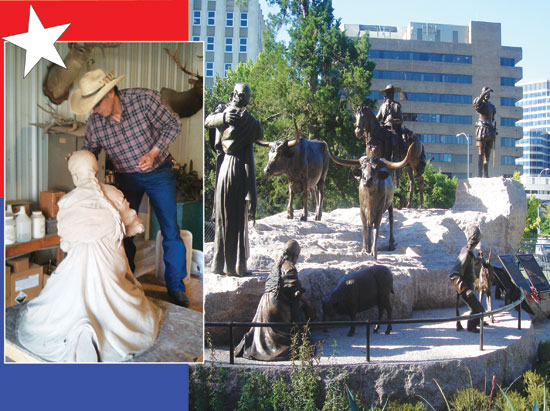
Monument honoring Tejanos’ historic contributions unveiled at state Capitol

Bryan Waites
The Signal
Alonzo Alvarez de Pineda mapped the Texas coast in 1519. In 1813 more than 1000 Tejanos died fighting for Texas’ independence from Mexico.
In 1836 Tejanos José Francisco Ruiz, José Antonio Navarro and Lorenzo de Zavala signed the Texas Declaration of Independence.
176 years later, Texas has its first Tejano Monument, which was dedicated March 29 and stands on the south lawn of the Texas state capitol. The monument is among the largest on the Capitol grounds. At 525 square feet, the monument depicts a Spanish explorer, a longhorn bull and cow, a vaquero on his mustang, a girl with a sheep, a boy with a goat, and a couple holding an infant sculpted and bronzed, and emplaced atop a granite base. A series of plaques helps to tell the story of Tejano contributions throughout Texas history.
More than a thousand guests attended the unveiling ceremony in Austin. Ten years and three legislative bills in the making, its significance acknowledges the contributions of Tejanos throughout the storied history of the Lone Star State.
“The Tejano Monument places formal recognition of Tejano history and contributions in the most public spot in Texas – the Capitol,” said Andrés Tijerina, professor of history at Austin Community College and vice-president of the board of directors of the Tejano Monument. “It has five bronze plaques with textual explanation of the Tejano historical role and it has statues to illustrate that history. The statues depict all of the icons and features that modern Texans are most proud of and it documents that those icons are Tejano in origin.”
Spectators at the event were both excited and proud of the monument.
“To have a monument that reflects not only the history of Tejanos, who have made many contributions to Texas, but also the values they share, makes me proud to be a part of this rich past,” said George Reyes, president-elect of the Texas Association of Chicanos in Higher Education.
The sculptures were a creation of Laredo artist Armando Hinojosa.
“This monument is about telling the true history of Texas,” Hinojosa said. “It doesn’t put one group of people against the other. Actually, all of the people who were here in
Texas at the time were called Tejanos (from Texas) therefore, my ancestors [being] who they were is not the most important thing for me. This is about all Tejanos – ‘Texans’ who with bleeding hands and feet and broken hearts carved out this beautiful land so that we can now stand here and enjoy it. This monument means to me that everyone’s contributions are important to our great state.”
Of his research and development for the monument, Hinojosa said there was a team of historians on the Tejano Board that kept him informed of their ideas as he designed and sculpted the different pieces for the monument.
“In essence, it feels as if I have been preparing my whole life to sculpt this monument,” Hinojosa said. “It felt right and I feel that God guided me throughout the whole thing. At the dedication, I looked at the whole monument, and I almost couldn’t believe that I had done the whole thing. The calluses on my hands and eight fingers reminded me that indeed I had done it.”
Before the actual artwork commenced, the process for the monument began 12 years ago when McAllen physician Cayetano Barrera visited the Capitol and realized there was no representation of the Tejano contributions to Texas history on the Capitol grounds. After meetings with representatives of Texas Congress, legislation began in 2001 and three bills were passed to make the monument a reality.
In that legislation, more than $1 million in public funds were approved for the construction and development of the project and the rest was raised by way of public donation. Additionally, legislation was passed that allotted ground space on the south lawn of the Capitol.
“Comprising 10 statues and 12 figures, the Tejano Monument will command attention,” said Senator Judith Zaffirini (D-Laredo). “I was delighted to secure $1.1 million in state funding for it, to author related legislation, and to sponsor and pass House Bill 4114 (2009), which authorized its placement on the historic south grounds of our State Capitol.”
The significance of the monument for some, however, is more than historical.
“It gives me validity,” said Linda Contreras Bullock, UHCL assistant dean of student diversity. “It makes me valid. We are a group who has been acculturated for a really long time, and as other Latin American groups have come in we have been fragmented, so it is hard for us to unite and it is much easier to cast us aside, [the monument] validates that we were the original settlers of this land.”
Tijerina said that it has taken 500 years of Tejano contributions to have a permanent monument on the Capitol grounds because until the 1960s, racial discrimination excluded Mexican-Americans from entering college in appreciable numbers. Those Tejanos have since graduated and penetrated the publishing and college teaching fields. The cadre of Mexican-Americans who entered college in the 1960s are now the professional historians who are writing and teaching a scholarly Texas history that includes Tejano history.
“Because many people were not in positions of power or importance where they had a say so as to what should or should not be told,” Hinojosa said. “People are just beginning to get educated and are now reaching positions of power, like Senator [Judith] Zaffirini, that we can now start to showcase what we know and feel. Like all good things, it takes time, passion and money. I feel that the three are finally starting to come together.”
Zaffirini points out the history of Texas is the history of Tejanos.
“Any history of our state that does not acknowledge such contributions through the ages is incomplete,” Zaffirini said.
